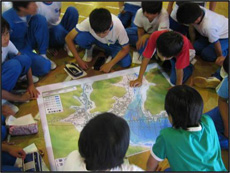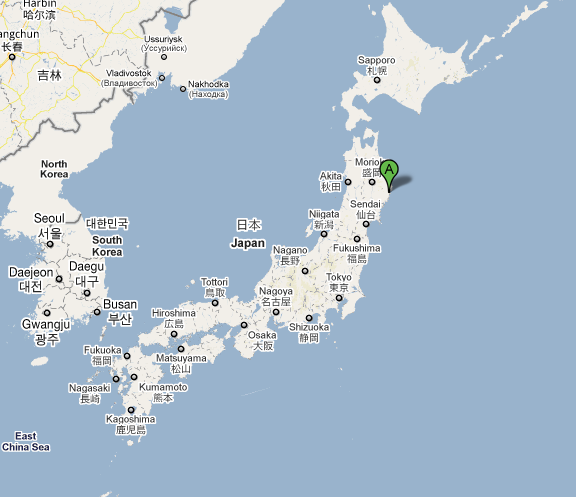Despite the fact that Unosumai Elementary School in Iwate-ken was engulfed by a tsunami (津波・tidal-wave), every one of the 350 students who were in the building at the time managed to escape, according to an article in the Asahi Shogakusei Shinbun published on March 24th.
When the ground started shaking, the students initially all ran to the 3rd floor of their school. However, when they saw the middle school students next door congregating in the playground, without waiting for instruction from their teachers, they ran down the stairs, met up with the 212 middle school students, and all together ran one kilometer to a nursing home on higher ground. From the safety of the hill, they watched the tsunami swallow their schools.
The site of both schools, approximately 130 miles (or 210 kilometers) north of Sendai

Of the 3,000 junior high and elementary school students in the district, only five are missing, four of which were absent from school that day.
This school district had been particularly well-equipped for such an event. Teachers brought in hazard maps created using data from the 1993 Hokkaido tsunami and held disaster preparedness classes for the students. The principal of the elementary school credits the fortunate outcome to the young students’ understanding of both the gravity of the situation and the immediate action required.

Although students go through emergency drills a few times a year, they are taught to remember three main things:
1. If the ground starts shaking, don’t go back to your house; run to high ground.
2. Don’t necessarily follow the hazard map; examine the current situation, consult with others, and make the best judgment.
3. Help others.
The Asahi article suggests one bear in mind two other qualities of tsunami: first, even if the tremors felt are relatively minor, a large tsunami can still develop; and secondly, that a tsunami can come in not just one large wave, but several phases; so even if the water does recede, one should never return to one’s house for supplies or possessions.
Jake’s note: These grade-schoolers were better prepared for disaster than the government of Japan. I wish we could replace Prime Minister Kan Naoto with the Unosumai School Principal.

Indeed, but it is worth contrasting the above with what happened here at Ookawa Elementary School described here
http://www.globalpost.com/dispatch/news/regions/asia-pacific/japan/110324/japan-ookawa-tsunami-earthquake
The full details of how the decision to stay in the playground was made are not detailed, but having worked for many years in the Japanese school system I can imagine that Endo-sensei must be one strong character to go against the consensus of the group – either arrived at as a group or decided upon by the principal or vice-principal. I can imagine Endo-sensei and the child who followed him are struggling with shock and survivors guilt and the events of that day will haunt them for the rest of their lives, but their decision to move makes them heroes.
What if the tsunami hadn’t reached Ookawa? I wonder if they would have been laughed at, mocked for over-reacting, for acting hysterically. Erring on the side of caution and preparing for the worst-case scenario in an uncertain situation may leave one feeling a embarrassed , even humiliated, if that scenario doesn’t come to pass. That, however, is a risk worth taking when one considers the possible alternative outcomes.
If the tsunami hadn’t reached Okawa, the Jinji Endo, would have been reprimanded and mocked for over-reacting. It take great courage for him to err on the side of caution and he saved a life in the process. It’s a shame that others did not follow his lead. In any society, not just Japan, it takes great courage to stand up for what you think is the right thing to do. If I ever get a chance, I’d love to shake Mr. Endo’s hand. I have a feeling that he probably is berating himself for not having done more to convince the others to follow him. On reporting and on blogging recent events, I’m always torn between being alarmist and being informative. I posted that radiation levels in Tokyo had risen substantially on the 13th, two days before Tokyo announced that the radiation levels in parts of the city were 21 times the normal values. It’s hard to put that number in context as well.
Endo-sensei is definitely a hero, but probably a very lonely hero. I admire him. I’m paraphrasing Rabbi Hillel, but he once said, “To save one life, is to save the world.” By that standard, he is great hero indeed.
Interesting.
Today’s Asahi Shogakusei paper has an article about a school where 70% of the students were swept away. The main point of the article is that the survivors are at another school and happy to see each other. I had a bit of an argument with my wife this morning about this. My comments were critical of the disaster preparation that resulted in such a loss. I said “Why after they gathered in playground for the earthquake didn’t they run on to the roof when they saw the water coming?” My wife held the line that the tidal wave was unprecedentedly large. Yes, I know I am sitting at my nice desk but the video that I have seen shows the water boring in over 5 minutes. There must have been some time to do something. Who knows, perhaps the students did run on to the roof and got swept away? The article did not interview any teachers who were at the school when it was hit. Very upsetting.
To bring this around to the posting here; it is great to hear that at least one school had trained its students and teachers properly. A good example for the rest of us.
Thank you.
You’re welcome. I didn’t see today’s paper yet. I was out all day but that’s a terrible tragedy. It’s a good thing to know as well.
Thank you for your comments, C.J. and Paul. There are lots of horror stories out there, for sure. I just wanted to also highlight one of the few hopeful ones that have come out of this last month.
What I read in another source was that the children were basically trained to think of their own safety first, and to not worry about their families, but rather to assume that they had also followed the same advice and reached for higher ground. I also read that the middle-schoolers grabbed the hands of reluctant younger students and ran to safety with them. I think that this is brilliant training, and something that should be routinely taught to all children. “Don’t look back, just run for your life.”
very poignant post.
Our 8 year old elementary age son who attends our local Japanese public school was looking at the picture in the paper of the elementary school that was wiped out and 70 of the pupils led into the oncoming Tsunami and very few survived. All he saw was the devastated school in the picture, but when I explained a bit of the story he said, “it’s not always right to do what the teacher says if you think it’s wrong, I would have climbed the mountain and gotten as high as I could” I hope he would have the strength to save himself and leave his friends and teachers who were following the leader and run for his life, but peer pressure and authority pressure is so strong- it is no wonder so many follow blindly.
I realize this comment is belated, but in various comments, I’ve seen people making much of the various stories where people followed instructions to go the regular place, didn’t flee to higher ground, and were killed. The same thing happened in 9/11 in the US, if you recall–people were instructed to stay in the building, and most people did. Anyway, the school in the story featured here is really remarkable–the degree of respect they’re showing for students by showing them the topographical maps is wonderful. I wish more schools in Japan, the US, and everywhere else would show that kind of respect (in emergency training and everything else). And I hope that we can all act like those students and Mr. Endo in emergency situations. Just make a deal with yourself now: it’s better to act and be alive to accept some ridicule or scolding later than to be found in a hospital or morgue later. Get your family and those you’re responsible for to make the same deal. (In all seriousness, making this kind of decision in advance really can help you act more decisively in the moment.)
Well-stated.
[…] From the safety of the hills above, they looked down to see the tsunami engulf their schools. Everyone survived. In fact, of the 3000 elementary and junior high school students in the entire district, only five […]